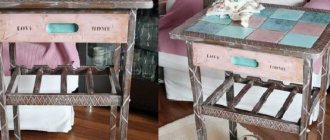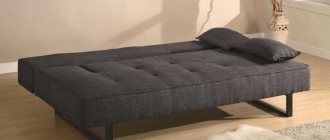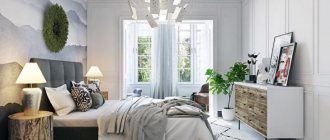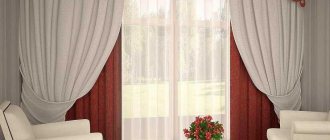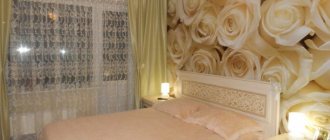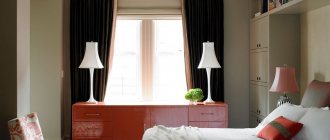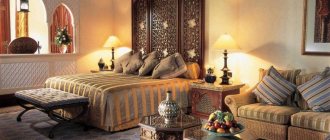Rack and pinion
Partitions made of slats, lamellas, beam sections are a laconic and environmentally friendly option. Such models are especially relevant for furnishings in the following styles: eco, Scandinavian, Japandi.
Photo: Instagram brus_decor
Photo: Instagram brus_decor
Photo: Instagram brus_decor
Photo: Instagram remont_na_kablukax
Mirror
Do you want to add “gloss” to your surroundings or visually enlarge the interior? Consider mirrored options. Disadvantage: the surface will require regular careful maintenance. However, you can always choose a decorative (for example, aged) mirror, on which minor dirt is less noticeable, and get around this drawback.
Photo: Instagram _8han_
Photo: Instagram atelier_de_maison
- Decoration
10 innovative ways to decorate your interior with mirrors
DIY screens
To make the simplest screen for a room with your own hands, you will need ready-made side shelving stands, acrylic enamel, a brush and long piano hinges (approximately 17 cm). You can use 6 door hinges. You also need to stock up on metal or felt chair supports and fabric.
From the tools you need to take:
- hammer;
- scissors;
- screws;
- screwdriver;
- iron;
- stapler.
At the first stage of work, the vertical supports-racks must be covered with enamel, and the required number of panels must be cut out of the fabric. On the sides of the panels, 10 cm are left as allowances, which are tucked and ironed.
The fabric is laid out on a flat surface face down and stretched. A crossbar stand is placed on top and wrapped with an edge of fabric, which is turned inside out and secured with staples. The stretched fabric is fixed and secured at the bottom. The same is repeated for the remaining parts of the screen.
The racks are connected with door or piano hinges and the thrust bearings are attached to the racks. The beautiful screen is ready!
Bamboo
Another eco-friendly material that is great for zoning is bamboo. It is not suitable for every interior, but it looks quite impressive and not bulky.
Photo: Instagram creativedecorsideas
Photo: Instagram kupi_bambuk
Photo: Instagram formulakomforta40
- Decoration Materials
How to choose and where to buy eco-friendly finishing materials
Openwork
Openwork partitions are a great way to bring a certain lightness to the atmosphere, add patterns and designs.
Geometric motifs look very impressive in the interior:
Photo: Instagram myhometut
Photo: Instagram liudmila_garandzhuk
Smooth lines and delicate patterns will help add femininity:
Photo: Instagram ais_design_studio
Photo: Instagram myhometut
Photo: Instagram olga_berkova
With extra storage
There are partitions with small shelves and cells. Such models are great for organizing additional storage and will help you squeeze the most out of a small area.
Photo: Instagram profcomplex_com
Photo: IKEA
Photo: Instagram profcomplex_com
Sliding and hinged partitions
Want more freedom to reconfigure your space? Take a closer look at sliding and swing models.
Photo: Instagram bsh_furniture
Photo: Instagram bsh_furniture
They will allow you to zone the space with a slight movement of your hand or, on the contrary, combine functional zones into one whole.
Photo: Instagram raumplus_ufa
Photo: Instagram raumplus_ufa
Agree, a very convenient and flexible option.
Photo: Instagram id_bedroom
loft_masters.msk
The invaluable advantages of the screen.
Screens of all designs, especially folding ones, are indispensable for one-room housing and useful in spacious ones. Performs several functions.
- Zoning. This is a simple tool for dividing space into zones. Without erecting permanent walls or inviting craftsmen to install suspended structures, a personal area, places for changing clothes, and a guest space are created in one room. Spacious rooms become more comfortable.
- Aesthetics. The screen decorates the room. You just need to coordinate the style of sliding or straight structures and the interior. In rooms with massive furniture, a fragile screen or curtain makes the atmosphere lighter.
- Practicality. The partition is mobile and can be easily moved to a new location. It can be removed or restored. When folded, the sliding screen is compact - a pantry or balcony is enough for storage.
- Versatility. Screen partitions are very convenient because they replace other, often bulky, objects and things. The screen on or opposite the window serves as a curtain. A design with shelves or pockets looks more elegant than a bookcase or rack. A beautiful unusual partition fills an empty corner.
The decorative and functional nature of the screen makes it a useful and sometimes irreplaceable part of the interior.
Textile
Textiles are a budget-friendly and easy-to-use way to zone a room. By the way, changing the design of such a partition if necessary is not difficult.
Photo: Instagram house_design_ideas
Photo: Instagram u.kvartira
Unexpected elements
Modern manufacturers also offer options with rather unexpected additions. How do you like, for example, this model, with elements made from living moss?
brus_decor
brus_decor
Choosing a partition screen
You should take a practical approach to choosing a screen for a room. To begin with, the purpose of its application is determined:
- distribution of space in the room;
- addition to the interior of the room;
- create a personal space where you can retire with a player or laptop.
At the next stage, they consider the type of screen and materials that are preferable to the consumer. Let's present some examples of combining the design of a screen with its functional purpose.
- Lightweight options. They mainly have a wooden frame, additionally decorated with light rattan or willow weaving. With the appearance of an amber or olive hue, there are ways to create a natural interior in the room. When decorated with bamboo with the addition of elements of climbing plants, you can create an imitation of a garden gazebo.
- When choosing partitions with a metal body, it is necessary to take into account that their weight will be significant. Moving them is problematic, so you should accurately determine their location. It is not possible to frequently change the zoning of a room using metal structures. It is better to use such partitions in large rooms. In order to visually add lightness to metal structures, it is necessary to choose models that have an openwork configuration. Additionally, we are considering the presence of protection for the legs of the metal partition with soft attachments to avoid damage to the floor covering.
A wide selection of forged products is presented by the French manufacturer ATHEZZA, the cost of which is about $352 with dimensions of 1.2x1.8 m. The unsurpassed “Fauna” model, decorated with elements from coinage, is offered by the country of the Philippines. Its cost is $590.
- In the case where a screen or room partition is needed to create your own personal space or small office, it is better to choose a product with many pockets and shelves. Sometimes such partitions are made of wood and are created permanently. Mobile screens can simply have several pockets in which frequently used items can be placed.
- The screen or screen does not fold into the room, and the product is installed permanently. The lower part is attached to the floor. Screen frames are made of wood or metal. The material for creating the screen can be anything. Occasionally screens are provided with wheels to give them mobility, but it should be noted that they will be less stable. Suitable for small spaces, since the screen method of construction takes up less space.
- A good solution for dividing a room into zones are mobile panels. If the goal is not only to divide the space, but also to decorate, then the best option would be Jilda mobile panels. Their range is quite wide. These models are used to decorate modern interiors in any style. You can select suitable models by visiting the Gilda online store.
Deaf
Who said that a blank partition cannot look light and elegant in the interior? Take a look at this wooden model: it doesn’t weigh down the space at all; on the contrary, it makes it more original and adds texture.
Photo: Instagram craftsmantim
Photo: Instagram craftsmantim
Screen in the interior: 33 examples for inspiration
Jean de Joost. Lavabo dos Encontros. Project by a French architect based in Rio de Janeiro. The highlight is a giant wooden panel screen created by architect Noel Marinho. Project as part of the decorator exhibition CasaCor São Paulo 2020.
Project by Spanish decorator Javier Castilla. In the living room there is a Chinese screen from the 19th century.
Italian architect Carla Venosta's apartment in Milan is a reflection of her life and career. The screen in the living room was constructed by the owner from the doors of a closet made by R. Mongiardino, a family friend.
Emiliano Salci and Britt Moran of Dimore Studio constantly change the design of their Milan gallery apartment on via Solferino. The photo shows the 2020 version.
Designer and decorator Sascha Valkhof, art director of Christian Lacroix, filled a Parisian apartment with art objects, creating an artistic and eclectic space.
Project by architect Nick Olsen as part of the Kips Bay Decorator Show House 2020.
Irakli Zaria created a pied-à-terre in London for Russian customers. The interior combined European vintage, Japanese antiques and modern art. The living room features custom Galerie Glustin screens.
Architect Ariana Ahmad designed the interior of an apartment of 126 sq. meters on the Patriarch's Ponds. In the bedroom there is a Gervasoni screen.
Anastasia Komarova designed a country house for a young family in the Belgian Village village. The screens in the bedroom are custom made.
Olga Amlinskaya created an apartment for a married couple with two children. The object is located in the famous House on Mosfilmovskaya. The master bedroom has a Hamilton Conte screen.
The portable partition appeared in the 7th century in China as protection against evil spirits. Once in Europe, it was considered a luxury item for many years. And today the screen is one of the most fashionable design items.
On the subject: Fashionable zoning: 45 solutions and 12 redevelopment methods
Paper or silk, wood or metal, glass or plastic, the screen is both functional and decorative. It can be easily folded, rearranged or even hung on the wall - transforming the space depending on your needs and mood.
An example of fashionable eclecticism was created in Paris by Antoine Simonan, Studio Asai. By the bedroom window is a Kin screen made of washi paper, Garnier & Linker.
A screen can become not only a replacement for static partitions or shelving for zoning a room; decorators know that with the help of a screen a lot can be adjusted, even the shape of the room.
The famous antique dealer and decorator Yves Gastou helped write a new history of an ancient building in Paris Saint-Germain. The fashionable jungle motif was added to the room by a Maison Jansen screen, 1950s (Galerie Jacques Hervouet).
For example, a corner screen will correct an ugly corner, a bright one will add an accent to the interior, a mirror one will visually increase the volume of the room. It will become a headboard in the bedroom or provide a small reading space, hide a wardrobe or separate a bath.
Ivana Sieberer designed a penthouse in London in Holland Park. In the master bedroom there is a French steel screen. XIX century installed at the head.
Designer Didier Benderly reconstructed the 1200 sq. m. chateau. meters. The screen was made by the Maury studio.
Designer Virginia Gash, VG Living, designs residential, office and commercial spaces. The designer invited guests to the Casa Decor Madrid 2020 exhibition to appreciate her extravagant, fantasy dining room.
Antwerp loft by designers Nienke Tinagel and Job Smets. A screen designed by Nienke separates the work area from the living area.
Designer Patricia Bustos de la Torre designed the interior of a temporary apartment for a family in Madrid. In the living-dining room, a screen made of brass and acrylic glass separates the sofa group from the dining room.
Decorator Anne-Sophie Payere transported the viewer into the world of high fashion. She treated the interior as a case for jewelry.
Reed and Delphine Krakoff filled their Manhattan mansion with expensive art and collectible designs.
Auctioneer Remy Le Fur filled his house with artistic items. In the living room there is a screen, design. M. Jallot (30s).
A New York couple, a developer and his wife, have been collecting art for 30 years. They own two apartments, which they combined to create the exhibition. In the bedroom there is an antique screen bought by the owners in Paris.
Design duo Emiliano Salci and Britt Moran, Dimorestudio, regularly update the decor of Milan apartments, turning the home into a contemporary design gallery. The combination of blue and green is the coloristic leitmotif of the interior. The sun protection screen, invented by J. Prouvé for African schools (1958–1962), harmoniously combines with the Dimorestudio screen.
French architect Jean Nouvel designed 24 suites in Rome's Palazzo Rhinoceros. The experimental hotel project The Rooms of Rome was created on the initiative of Fondazione Alda Fendi – Esperimenti.
The home of the Valois couple is a loft in the center of Paris. Ruhlmann's furniture sits alongside works by Sol LeWitt and Helmut Newton. Screen, design E. Gray. 1922.
In his home, cosmopolitan testmaker Stefan Hamel decided to create an atmosphere of a rich holiday with baroque motifs. In the kitchen there is a screen with a painting by R. Schwan-Reichman.
Nilufar Gallery: apartment exhibition art&design. The headboard is a screen by Martino Gamper. Contrasting with her are three pseudo-classical portraits of the Austrian Markus Schinwald.
Apartment in the center of Moscow - project of Harry Nuriev, Crosby Studios. A screen encloses the sleeping area. The arched ends of the screen, the rounded shapes of the furniture - all this counters the rigid structure of the loft.
Tatyana and Dmitry Khoroshev, architectural bureau Lighthouse, designed a family house near Moscow. In the guest bedroom there is an antique screen brought from Japan.
Dmitry Kuznetsov and Natalya Vorobyova, PropertyLab+art, created the interior for the Belgian gallery owner with Russian roots, Nadya Kotova-Massen. There is a screen in the living room, Ekaterina Rozhkova, pARTnerproject gallery.
When decorating an apartment in the center of Moscow, designer Kira Korotkova combined two of her favorite styles: Art Deco and Mid-century modern.
Tatyana Alenina designed an apartment for her family, the atmosphere of which is reminiscent of a country house. The co-author was Tatiana’s husband, Vladimir Krasilnikov. Holland & Sherry screens in the living room.
Designer Maria Vatolina designed an apartment of 67 square meters. meters. There is a vintage Chinese screen in the bedroom.
Designer and decorator Olga Koshcheeva, Studio 5.15, designed the interior of an office on the 43rd floor of a tower in Moscow City. The screen was made to order. According to the designer, on sunny days it creates a dynamic play of light and shadow.
Combined
Combined solutions are the best choice in many cases. There are models made from combined materials: for example, glass options are often complemented with textiles, this allows you to literally turn a transparent partition into an opaque one in just a couple of seconds.
It is also not uncommon to combine solid partitions with glass ones: this way you can hide everything unnecessary from prying eyes, while maintaining the volume of the room and not blocking access to sunlight.
Photo: Instagram shtabdesigns
Photo: Instagram argentymartdes
Photo: Instagram veter.olga.1976
Types of screens in the interior of a room
When it comes to zoning residential premises, accordion screens are often used for this. They are made from different materials, and this has already been mentioned above. But it should be noted that the assembled partition is not the only option. There is a fairly wide range of models, so we will consider each of them separately.
Casement partitions
This is a classic version - an accordion, consisting of several frames connected by hinges. Usually simple hinges (piano or furniture) are used for this. The number of shutters is limited only by the dimensions of the room, but traditionally there are three, maximum four, in a screen of this design.
Expert's point of view
Yaroslava Galayko
Lead designer and studio manager at Ecologica Interiors
Ask a Question
“As for the dimensions of the doors, the height varies from 1.5 to 1.8 m, the width of each door is 40-60 cm. But these are just recommended values, although, as the time of operation of accordion screens has shown, these are the most convenient sizes."
Most often, these screens are used as partitions. But today designers offer various variations of the installation of partitions, where screens are often assigned purely decorative content to the interior. The photo below shows just such an option.
Screen as a decorative element of a room's interior
Single screen partitions
This type of screen consists of one leaf, so they have only one drawback - they cannot be folded. But this is not always a disadvantage, because this design is flat, so it will not take up much space. On the other hand, single-screen partitions cope with their responsibilities 100%.
They are convenient because they create the illusion of a small wall, so they are very convenient when the task is to zone rooms. Let us add that partitions of this type are very often used in office premises, which are divided into many workplaces. As for living rooms, here designers use them in different directions, but more often as a dividing element.
At the same time, some models are used as stationary structures, others are used as portable ones. The latter are equipped with legs or wheels for ease of movement.
Screen partition on wheels
Flexible screens
From the name itself it becomes clear that this variety is in some way different from the others, especially from the classic form in the form of frame-leaves. In this model, the base is vertical posts, between which flexible material is stretched. The latter is located horizontally. That is why screens of this variety can take on bizarre shapes; they are easy to roll up and put away.
Another type of flexible screens are vertically located elements that are attached with hinges or flexible inserts to each other. There are no racks, the entire structure is narrow elements that are mounted on horizontal guides. The latter themselves are made of flexible material.
Flexible partition in expanded form
Screens
This is a subtype of single-screen models. Although some designers classify them as a type of roller blinds that are suspended and attached to the ceiling. A good option for bedrooms, because in this way you can separate the bed from the entire room with a thin fabric. Although, as practice shows, panels are also hung in living rooms, separating the rest area from the work area.
As for the material from which the panels are made, the variety is not very large. The main material is fabric (in principle, any), synthetic fabrics (mesh or solid). Sometimes designers even solve problems related to the load-bearing capacity of this type of screen. They hang a TV, paintings and other interior accessories.
Screen-partition in the form of a panel suspended from the ceiling
Original designs
The popularity of screens is growing every year, and this is facilitated by their huge range in terms of variety of shapes, sizes, materials and design ideas. The latter criterion has become the driving force in product advertising today. The original approach to the manufacture of partitions gave impetus to the emergence of a class of consumers who monitor new products and try to purchase them. In this case, not only the quality and originality of the design are taken into account, many are concerned about the price aspect. Therefore, today buying a screen for a room inexpensively is not a problem.
So, a few photos of the original models:
